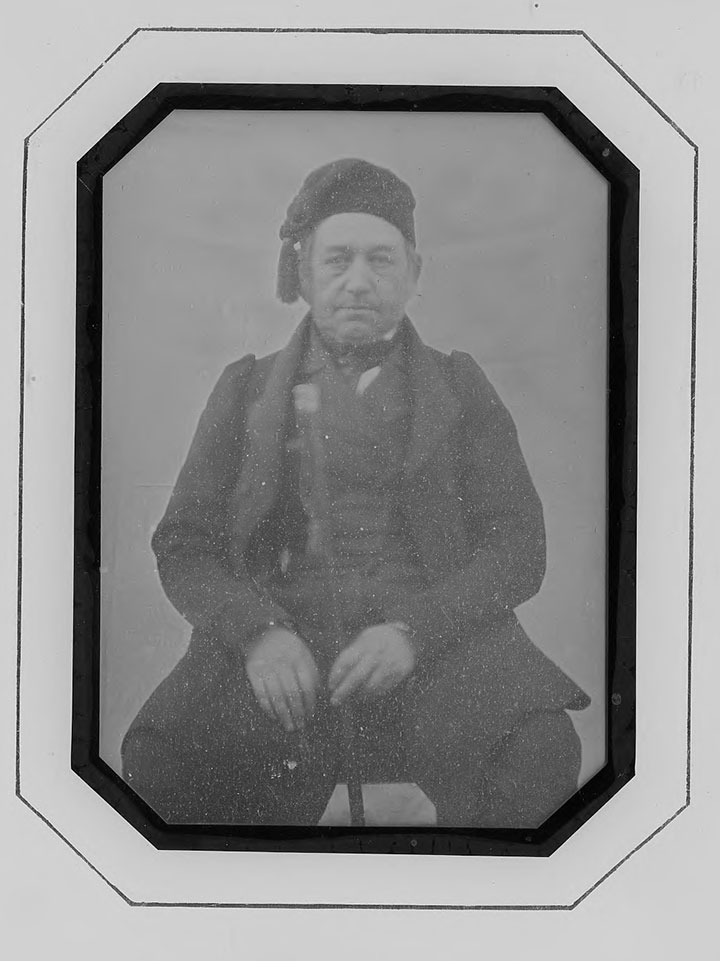1837 The First Photo

Louis J.M. Daguerre developed the first daguerreotype photo.
Louis-Jacques-Mandé Daguerre, a French artist and physicist, is celebrated as one of the founding figures of photography for his development of the daguerreotype, the first commercially viable photographic process. Born on November 18, 1787, in Cormeilles-en-Parisis, France, Daguerre initially pursued a career in the arts, training as a painter and scenic designer. He became renowned for his work on theatrical set designs and his invention of the diorama, an immersive theatrical experience that combined large, painted backdrops with lighting effects to simulate natural scenes. However, Daguerre’s true legacy emerged from his interest in capturing real-life images in a permanent form, leading to his groundbreaking invention in photography.
In the early 19th century, capturing images was a dream pursued by various inventors and scientists. Daguerre began experimenting with light-sensitive materials around 1824, influenced by the work of Nicéphore Niépce, a fellow Frenchman who had successfully captured the first known photograph in 1826 using a process he called heliography. Niépce’s technique, while pioneering, required extremely long exposure times and did not produce sharp images. In 1829, Daguerre and Niépce formed a partnership to refine and advance photographic techniques. Niépce passed away in 1833, but Daguerre continued to build on his colleague’s discoveries, eventually leading him to invent the daguerreotype.
By 1837, Daguerre had perfected his process, which involved a silver-plated copper sheet treated with iodine vapor, making it light-sensitive. After exposing the plate to light in a camera, the image was developed using mercury vapor and fixed with a solution of common salt. This innovative method allowed Daguerre to produce sharp, detailed images in a relatively short amount of time, revolutionizing the way images could be captured. The resulting daguerreotype image was a one-of-a-kind mirror-like plate that could not be reproduced, but it marked a significant breakthrough in the pursuit of permanent images.
Daguerre’s invention received widespread recognition in 1839 when the French Academy of Sciences announced the process to the world. The French government, recognizing the cultural and scientific significance of Daguerre’s work, purchased the rights to the daguerreotype process, making it freely available to the public as a “gift to the world.” In exchange, Daguerre and Niépce’s son, Isidore, received lifetime pensions. This decision helped spread the daguerreotype process quickly, and it was soon adopted by photographers and artists across Europe and America.
The daguerreotype process became immensely popular and led to the establishment of photography studios throughout Europe and the United States. It allowed people, for the first time, to create detailed, realistic portraits and images of landscapes, buildings, and everyday life. Portrait studios emerged, and photography became accessible to the general public, who could now preserve images of loved ones and memorable scenes. However, the process had limitations; the plates were delicate and could tarnish if not properly sealed, and exposure times were still long, making it challenging to photograph moving subjects.
Despite these limitations, Daguerre’s invention is credited with launching the modern era of photography. The daguerreotype dominated photography until the 1850s when new techniques, such as the collodion process, began to offer greater flexibility and reproducibility. Nonetheless, Daguerre’s work laid the foundation for all subsequent photographic advancements, transforming art, science, and historical documentation forever. Today, Louis Daguerre is remembered as a visionary whose contributions helped shape the way we capture and preserve visual history.
 >
>